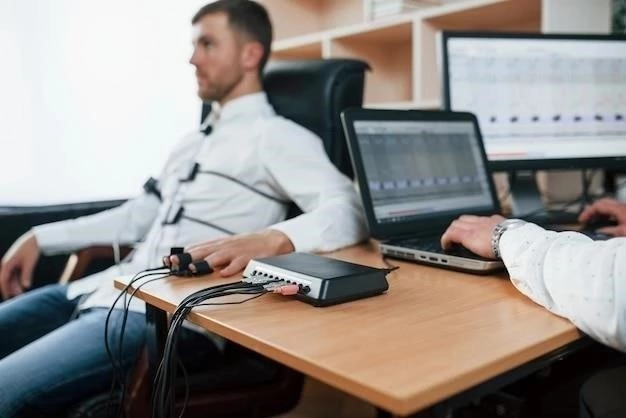The polygraph, commonly known as the “lie detector,” has been a source of fascination and controversy for decades. Immortalized in popular culture and employed in various settings, from criminal investigations to employee screenings, its often perceived as a foolproof instrument for discerning truth from deception. However, the reality of polygraph testing is far more nuanced than its portrayal in fiction. This article delves into the myths and realities surrounding polygraphs, examining the science behind the technology, its limitations, and its place in modern society.
How Polygraphs Work: A Physiological Approach
A polygraph doesnt detect lies directly. Instead, it measures physiological responses believed to be associated with deception. The underlying principle is that lying induces stress and anxiety, leading to measurable changes in the body. A standard polygraph examination involves connecting an individual to sensors that monitor several physiological indicators:
- Heart rate: Measures the speed at which the heart beats;
- Blood pressure: Records the force of blood against artery walls.
- Respiration: Monitors breathing patterns and depth.
- Skin conductivity: Measures changes in sweat gland activity.
During the examination, a trained polygraph examiner, often referred to as a polygraphist, asks a series of questions while these physiological parameters are recorded. The questions are typically a mix of control questions, designed to elicit a predictable response, and relevant questions, related to the specific issue under investigation. The examiner analyzes the fluctuations in the physiological data, comparing the responses to control and relevant questions to assess the likelihood of deception.
Debating Accuracy: The Controversy Surrounding Polygraph Results
The accuracy of polygraph testing has been the subject of intense debate within the scientific community and beyond. Proponents of the technology point to studies suggesting accuracy rates ranging from 80% to 90%٫ claiming that a well-trained examiner can effectively identify deception. However٫ critics argue that these figures are inflated and that the accuracy of polygraph testing is significantly lower in real-world settings.
Several factors contribute to the difficulty in definitively determining polygraph accuracy:
- Lack of a Unique Physiological Signature for Lying: There is no single physiological response that definitively indicates deception. Anxiety, fear, and other emotional states can trigger similar physiological changes, potentially leading to false positives.
- Individual Variations in Physiological Responses: People respond to stress and anxiety differently. Some individuals exhibit minimal physiological changes when lying, while others show significant fluctuations even when telling the truth, potentially leading to false negatives.
- Examiner Subjectivity and Bias: The interpretation of polygraph data involves a degree of subjectivity. Examiner bias, conscious or unconscious, can influence the analysis and conclusions drawn from the physiological recordings.
- Countermeasures: Individuals can be trained to manipulate their physiological responses during a polygraph examination, potentially rendering the test ineffective. Techniques like biting the tongue, pressing the feet against the floor, or mentally engaging in distracting thoughts have been reported to influence results.
Legal and Ethical Considerations: The Use of Polygraphs in Different Contexts
The legal admissibility of polygraph evidence varies widely across jurisdictions. In the United States, federal law generally prohibits employers from using polygraphs for pre-employment screening or during employment. However, exceptions exist for certain government agencies and positions involving national security or public safety. In criminal cases, the admissibility of polygraph results is often determined on a case-by-case basis, with judges weighing the potential probative value against the risk of prejudice.
Beyond the legal considerations, the use of polygraphs raises ethical concerns:
- Potential for Coercion and False Confessions: The perceived infallibility of polygraphs can create a coercive environment, potentially leading innocent individuals to confess to crimes they did not commit.
- Privacy Violations: Polygraph examinations delve into personal and sensitive information, raising concerns about privacy violations, particularly in employment screenings.
- Erosion of Trust: The use of polygraphs can create an atmosphere of suspicion and distrust, potentially damaging relationships and undermining confidence in institutions.

Conclusion: The Polygraph ⏤ An Imperfect Tool
The polygraph, despite its portrayal as a reliable lie detector, is an imperfect tool with limitations that must be acknowledged. While it can be a useful investigative aid in some circumstances, it should never be considered conclusive evidence of guilt or innocence. The decision to use a polygraph, and the weight given to its results, should always be made with a clear understanding of its capabilities and limitations, ensuring fairness, transparency, and a commitment to ethical practices.
Beyond the Binary: The Limitations of Truth and Deception
A core issue often overlooked in the polygraph debate is the inherent complexity of truth and deception themselves. Human communication is nuanced, and individuals may hold beliefs or memories that are inaccurate or incomplete without intentionally deceiving. The polygraph, however, operates on a binary model, seeking to categorize responses as either truthful or deceptive. This simplistic approach fails to account for the myriad cognitive and emotional factors that influence an individuals responses during an examination.

Alternatives and Adjuncts to Polygraph Testing
Recognizing the inherent limitations of polygraphs, researchers and practitioners have explored alternative methods for credibility assessment. Some promising avenues include:
- Brain-Based Measures: Techniques like functional magnetic resonance imaging (fMRI) and electroencephalography (EEG) offer insights into brain activity, potentially providing more objective indicators of deception. However, these methods are still in their infancy and face challenges related to cost, practicality, and ecological validity.
- Linguistic Analysis: Examining an individuals language patterns, both verbal and nonverbal, can reveal subtle cues associated with deception. Researchers are developing sophisticated algorithms that analyze linguistic markers, such as pronoun usage, verb tense, and voice pitch, to detect inconsistencies and potential deception.
- Behavioral Analysis: Trained investigators can observe an individuals behavior, including facial expressions, body language, and verbal responses, for signs of deception. While behavioral analysis is inherently subjective, it can provide valuable contextual information when combined with other assessment methods.

The Future of Deception Detection: A Multifaceted Approach
The quest for a foolproof lie detector is likely to remain elusive. Rather than seeking a singular, definitive solution, the future of deception detection lies in a multifaceted approach that integrates multiple measures and considers the psychological complexities of human behavior. Advancing our understanding of the neural, physiological, and behavioral correlates of deception, while acknowledging the limitations of any single method, will be crucial for developing more reliable and ethically sound approaches to credibility assessment.










